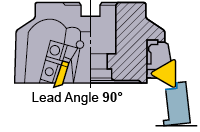![]() Aço
Aço
![]() Aço inoxidável
Aço inoxidável
![]() Ferro fundido
Ferro fundido
![]() Metal não ferroso
Metal não ferroso
![]() Material de difícil usinabilidade
Material de difícil usinabilidade
![]() Material endurecido
Material endurecido

Lead Angle 90°
Back force is in the minus direction. Lifts the workpiece when workpiece clamp rigidity is low.

Lead angle 75° is recommended for face milling of workpieces with low rigidity such as thin workpieces.

The largest back force.
Bends thin workpieces and lowers cutting accuracy.
* Prevents workpiece edge chipping when cast iron cutting.

* Principal force : Force is in the opposite direction of face milling rotation.
* Back force : Force that pushes in the axial direction.
* Feed force : Force is in the feed direction and is caused by table feed.
When the depth of cut and feed per tooth, fz, are fixed, the smaller the lead angle (KAPR) is, then the thinner the chip thickness (h) becomes (for a 45° KAPR, it is approx. 75% that of a 90° KAPR). This can be seen in below. Therefore as the KAPR increases, the cutting resistance decreases resulting in longer tool life. Note however, if the chip thickness is too large then the cutting resistance can increase leading to vibrations and shortened tool life.

Below shows wear patterns for different lead angles. When comparing crater wear for 90° and 45° lead angles, it can be clearly seen that the ctater wear for 90° lead angle is larger.

Fale conosco
Formulário para contato Japão
Japão  Japão
Japão  Estados Unidos
Estados Unidos  México
México  Brasil
Brasil  EU
EU  Reino Unido
Reino Unido  Alemanha
Alemanha  Espanha
Espanha  França
França  Itália
Itália  Polônia
Polônia  Turquia
Turquia  Tchéquia
Tchéquia  China
China  Asia Pacific
Asia Pacific  Tailândia
Tailândia  Vietnã
Vietnã  Indonésia
Indonésia  Índia
Índia ![]() Aço
Aço
![]() Aço inoxidável
Aço inoxidável
![]() Ferro fundido
Ferro fundido
![]() Metal não ferroso
Metal não ferroso
![]() Material de difícil usinabilidade
Material de difícil usinabilidade
![]() Material endurecido
Material endurecido
![]() Acabamento
Acabamento
![]() Usinagem média
Usinagem média
![]() Desbaste
Desbaste